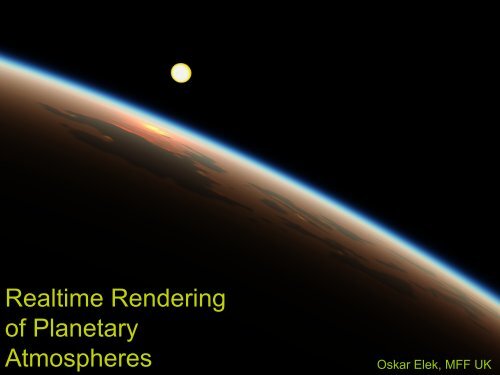Examples of light scattering
Examples of light scattering
Examples of light scattering
Create successful ePaper yourself
Turn your PDF publications into a flip-book with our unique Google optimized e-Paper software.
Realtime Rendering<br />
<strong>of</strong> Planetary<br />
Atmospheres Oskar Elek, MFF UK
Talk outline<br />
Introduction<br />
<strong>light</strong>, atmosphere, <strong>light</strong> <strong>scattering</strong><br />
<strong>Examples</strong> <strong>of</strong> <strong>light</strong> <strong>scattering</strong><br />
Calculation <strong>of</strong> <strong>light</strong> <strong>scattering</strong><br />
Visualisation<br />
precomputation<br />
rendering<br />
comparation<br />
Why bother?<br />
Interactive demonstration
Talk outline – part I<br />
Introduction<br />
<strong>light</strong>, atmosphere, <strong>light</strong> <strong>scattering</strong><br />
<strong>Examples</strong> <strong>of</strong> <strong>light</strong> <strong>scattering</strong><br />
Calculation <strong>of</strong> <strong>light</strong> <strong>scattering</strong><br />
Visualisation<br />
precomputation<br />
rendering<br />
comparation<br />
Why bother?<br />
Interactive demonstration
Light I<br />
Often simplified to RGB triplets<br />
“Light is electromagnetic radiation that is visible<br />
to the human eye.”<br />
Main attributes:<br />
Amplitude Intensity<br />
Wavelength Colour<br />
Polarisation
Light II<br />
Color determined by<br />
spectral composition<br />
Example: blackbody<br />
radiation from Sun<br />
Wave-particle duality – Albert Einstein 1900s<br />
Wave – interference, <strong>scattering</strong>…<br />
Particle – <strong>light</strong> pressure<br />
Every particle is dual (de Broglie 1929)
Light III<br />
Common abstraction in realtime CG – ray<br />
Radiant flux<br />
Can be diverged and attenuated<br />
Polarisation<br />
Orientation <strong>of</strong> oscillations<br />
Linear, circular or elliptical<br />
Can lead to attenuation <strong>of</strong> <strong>light</strong>
Atmosphere<br />
Earth’s atmosphere<br />
Gas molecules<br />
N 2 , O 2 , CO 2 …<br />
Larger (aerosol) particles<br />
Water droplets, dust, ice crystals, ash…<br />
The density (and pressure) drops<br />
down exponentially:<br />
H 0 - scale height<br />
Gases ~ 8km (5.6km for exp2())<br />
Aerosols ~ 1.2km (1.7km for exp2())
Light <strong>scattering</strong><br />
“Light <strong>scattering</strong> is process when the <strong>light</strong><br />
passing through participating medium is forced<br />
to deviate from original trajectory.”<br />
Reason <strong>of</strong> many phenomena, incl. color <strong>of</strong><br />
atmosphere<br />
Denser medium ~ higher probability <strong>of</strong> <strong>scattering</strong><br />
event<br />
Angular <strong>scattering</strong> pattern<br />
(distribution) given by<br />
phase function<br />
λ
Light <strong>scattering</strong> classification<br />
Elastic<br />
Rayleigh <strong>scattering</strong><br />
Mie <strong>scattering</strong><br />
Takes place in the atmosphere<br />
Inelastic (energy loss)<br />
Special<br />
Raman <strong>scattering</strong><br />
Brillouin <strong>scattering</strong><br />
Rutherford <strong>scattering</strong> (α-particles on gold foil)
Rayleigh <strong>scattering</strong><br />
J. W. Strut – 3 rd Lord Rayleigh, 1871<br />
Light <strong>scattering</strong> on particles<br />
At r~10nm transition to Mie <strong>scattering</strong><br />
1 / λ 4 dependency<br />
(730/380) 4 = 13.6 times more blue<br />
than red <strong>light</strong> scattered<br />
y-symetric phase function<br />
Approximation:
Mie <strong>scattering</strong><br />
German physicist Gustav Mie, 1908<br />
Light <strong>scattering</strong> on larger particles (x ~1 and<br />
more)<br />
No general λ dependency<br />
Phase function<br />
strongly anisotropic<br />
Analytical approximation<br />
by Cornette-Shanks
Multiple <strong>scattering</strong><br />
So far only single bounce discussed<br />
Rayleigh and Mie are elastic ‘infinite’ number<br />
<strong>of</strong> bounces<br />
Main difference:<br />
Single <strong>scattering</strong> – random occurrence (scatterer position<br />
uncertainity) – described by probability distribution<br />
Multiple <strong>scattering</strong> – averaged deterministic behaviour to<br />
high degree<br />
Can turn strongly anisotropic<br />
<strong>scattering</strong> medium into isotropic<br />
in terms <strong>of</strong> global phase function<br />
(i.e. clouds – cca 30 bounces)
Talk outline – part II<br />
Introduction<br />
<strong>light</strong>, atmosphere, <strong>light</strong> <strong>scattering</strong><br />
<strong>Examples</strong> <strong>of</strong> <strong>light</strong> <strong>scattering</strong><br />
Calculation <strong>of</strong> <strong>light</strong> <strong>scattering</strong><br />
Visualisation<br />
precomputation<br />
rendering<br />
comparation<br />
Why bother?<br />
Interactive demonstration
<strong>Examples</strong> <strong>of</strong> <strong>light</strong> <strong>scattering</strong> I<br />
Subsurface skin<br />
<strong>scattering</strong><br />
Translucent<br />
materials (wax,<br />
marble…)<br />
Smoke, haze<br />
Human eyes<br />
(combined with<br />
absorptive<br />
reflectivity)<br />
Water blue (minor<br />
share)<br />
Animal realm<br />
(feathers, butterflies,<br />
reptiles – sharing<br />
colorfulness with<br />
interferential<br />
iridescence)
<strong>Examples</strong> <strong>of</strong> <strong>light</strong> <strong>scattering</strong> II<br />
Colour <strong>of</strong> the atmosphere<br />
Rayleigh <strong>scattering</strong> – chromatic parts<br />
Mie <strong>scattering</strong> – achromatic (λ-independence)
Talk outline – part III<br />
Introduction<br />
<strong>light</strong>, atmosphere, <strong>light</strong> <strong>scattering</strong><br />
<strong>Examples</strong> <strong>of</strong> <strong>light</strong> <strong>scattering</strong><br />
Calculation <strong>of</strong> <strong>light</strong> <strong>scattering</strong><br />
Visualisation<br />
precomputation<br />
rendering<br />
comparation<br />
Why bother?<br />
Interactive demonstration
Scattering integral - sketch
Optical length<br />
Expresses attenuation along given path in<br />
participating medium<br />
S …… path length<br />
K …… density constant (sea level)<br />
ρ …… density scale function (0≤ρ≤1)<br />
Without 1 / λ 4 for Mie <strong>scattering</strong>
Scattering integral<br />
Scattered <strong>light</strong> coming from certain direction<br />
(single <strong>scattering</strong> only!)<br />
I V<br />
…… incoming scattered <strong>light</strong><br />
Suitable for procedural calculation <strong>of</strong> <strong>light</strong><br />
<strong>scattering</strong>
Scattering integral - analyse<br />
I i<br />
…… incident <strong>light</strong><br />
F R …… phase function (at <strong>scattering</strong> angle θ)<br />
K …… atmosphere density constant
Scattering integral - analyse<br />
Integrating along view ray S – in-<strong>scattering</strong> phase<br />
P a …… first point on S where ρ(h)>0<br />
P b …… last point on S where ρ(h)>0
Scattering integral - analyse<br />
Attenuation function at sample point P – out<strong>scattering</strong><br />
phase<br />
PP c …… path in direction <strong>of</strong> <strong>light</strong><br />
PP a …… path to observer
Talk outline – part IV<br />
Introduction<br />
<strong>light</strong>, atmosphere, <strong>light</strong> <strong>scattering</strong><br />
<strong>Examples</strong> <strong>of</strong> <strong>light</strong> <strong>scattering</strong><br />
Calculation <strong>of</strong> <strong>light</strong> <strong>scattering</strong><br />
Visualisation<br />
precomputation<br />
rendering<br />
comparation<br />
Why bother?<br />
Interactive demonstration
Precomputation<br />
‘Compute & store’ concept<br />
In some data structure (kD texture on graphics HW)<br />
Critical assumptions:<br />
Sensible behaviour <strong>of</strong> target function (classical<br />
sampling problem)<br />
Sensible dimensionality <strong>of</strong> TF<br />
‘Sensible’ means at most 4-5 DoF<br />
Otherwise data will grow too large<br />
Fetch data during rendering<br />
Assuming ‘fetch’ is fast enough
Precomputation <strong>of</strong> atmospheric<br />
<strong>light</strong> <strong>scattering</strong><br />
We want <strong>light</strong> intensity for:<br />
Every observer position ~ P[p x ,p y ,p z ] … 3 DoF<br />
Every observer view direction ~ V[v x ,v y ,v z ] … 3 DoF<br />
Every daytime (<strong>light</strong> direction) ~ L[l x ,l y ,l z ] … 3 DoF<br />
9 DoF is too many<br />
Let’s assume:<br />
Atmosphere is spherical with exponential density<br />
fall<strong>of</strong>f, isotropic otherwise<br />
Earth surface is spherical<br />
Light rays from Sun are parallel (20” at most)
Precomputation <strong>of</strong> atmospheric<br />
<strong>light</strong> <strong>scattering</strong> – 1st try<br />
Representing<br />
Observer position as altitude ~ h … 1 DoF<br />
Observer view direction as view-zenith angle ~ θ … 1 DoF<br />
Light direction as <strong>light</strong>-zenith angle ~ δ … 1 DoF<br />
gives us only 3 DoF!<br />
What’s the catch?<br />
We neglect the<br />
azimuth from the Sun
Precomputation <strong>of</strong> atmospheric<br />
<strong>light</strong> <strong>scattering</strong> – 2nd try<br />
Everything stays, but we add azimuth ~ ω … 1 DoF<br />
Problem – graphics HW supports only 3D textures!<br />
Use vertical tiling<br />
Problem – data are too large!<br />
Use nonlinear importance mapping for sampling texture’s<br />
parameters (priorize areas with larger gradient)<br />
One more flaw – Mie<br />
phase function<br />
Is too steep! (forward<br />
lobe)<br />
Deferred evaluation (in<br />
fragment shader)
Multiple <strong>scattering</strong><br />
Single <strong>scattering</strong> computation complexity is C*n2 for every texel (C not neglectable)<br />
n … sampling rate<br />
Multiple <strong>scattering</strong> – Ck *(n2 +n3 ) k per texel!<br />
k … number od orders<br />
Brute force approach will ‘never’ finish<br />
Solution – dynamic programming<br />
1) Compute 1. order normally and store it<br />
2) Each k. order compute from stored (k-1). order as if<br />
computing single <strong>scattering</strong> (with a bit more<br />
complicated gathering step)<br />
New complexity C*n2 + (k-1)*(C*n2 +C*n3 )<br />
‘n3 ’ term now very fast (n*n2 fetching op-s)<br />
Result – complexity almost linear in relation to k (!!)
Spectral precomputation<br />
Tens <strong>of</strong> spectral values instead RGB triplet<br />
λ sampling as next DoF<br />
Computational cost grows up only few %<br />
λ only multiplies integrals<br />
Conversion spectrumRGB before storing
Rendering I<br />
CPU-based precomputation<br />
GPU-based realtime renderer<br />
Sky and planet represented<br />
by simple tesselated spheres<br />
Sky is simple<br />
1) Calculate h, θ, δ and ω in the fragment shader<br />
2) Fetch the sky colour
Rendering II<br />
Ground is little bit harder<br />
1) Scattering same as sky<br />
2) Add direct illumination (after attenuation)<br />
3) Add water reflections<br />
Precomputed data serve as environment texture
Comparation – ‘engines’<br />
Evening sky during sunset<br />
Real photo<br />
(continental<br />
sky, Prague)<br />
Non-realtime<br />
system (Maxwell<br />
Render)<br />
Realtime<br />
system (my<br />
renderer)
Comparation – single vs multiple LS<br />
Single <strong>scattering</strong><br />
Multiple <strong>scattering</strong>
Talk outline – part V<br />
Introduction<br />
<strong>light</strong>, atmosphere, <strong>light</strong> <strong>scattering</strong><br />
<strong>Examples</strong> <strong>of</strong> <strong>light</strong> <strong>scattering</strong><br />
Calculation <strong>of</strong> <strong>light</strong> <strong>scattering</strong><br />
Visualisation<br />
precomputation<br />
rendering<br />
comparation<br />
Why bother?<br />
Interactive demonstration
Who need realtime atmosphere?<br />
Majority <strong>of</strong> 3D games<br />
FPSs, RTSs, RPGs, racers, f<strong>light</strong> sims, ...<br />
Pr<strong>of</strong>essional f<strong>light</strong> simulators (training purposes)<br />
Aircraft pilots<br />
Spacecraft pilots<br />
Animated movies<br />
Much less (maybe interactive ones?)<br />
Scientific visualisations<br />
Meteorology, climatology, …
Talk outline - conclusion<br />
Introduction<br />
<strong>light</strong>, atmosphere, <strong>light</strong> <strong>scattering</strong><br />
<strong>Examples</strong> <strong>of</strong> <strong>light</strong> <strong>scattering</strong><br />
Calculation <strong>of</strong> <strong>light</strong> <strong>scattering</strong><br />
Visualisation<br />
precomputation<br />
rendering<br />
comparation<br />
Why bother?<br />
Interactive demonstration
Thank you for your attention!<br />
Questions?
References, further information<br />
Elek Oskar: Rendering Planetary Atmospheres in Real-<br />
Time, Bachelor Thesis, MFF UK, 2008<br />
Nishita T., Sirai T., Tadamura K., Nakamae E.: Display<br />
<strong>of</strong> The Earth Taking into Account Atmospheric Scattering,<br />
Siggraph ’93: Proceedings <strong>of</strong> the 20th annual conference<br />
on Computer graphics and interactive techniques, 175-<br />
182, 1993<br />
Schafhitzel T., Falk M. and Ertl T.: Real-Time Rendering<br />
<strong>of</strong> Planets with Atmospheres, Journal <strong>of</strong> WSCG, Vol. 15,<br />
2007<br />
Bruneton E. and Neyret F.: Precomputed Atmospheric<br />
Scattering, 19th Eurographics Symposium on Rendering,<br />
EGSR08, Sarajevo, 2008<br />
Keywords: atmospheric <strong>light</strong> <strong>scattering</strong>, Rayleigh<br />
<strong>scattering</strong>, Mie <strong>scattering</strong>, multiple <strong>scattering</strong>, spectral<br />
rendering<br />
My homepage: http://www.oskee.wz.cz/stranka/oskee.php

















